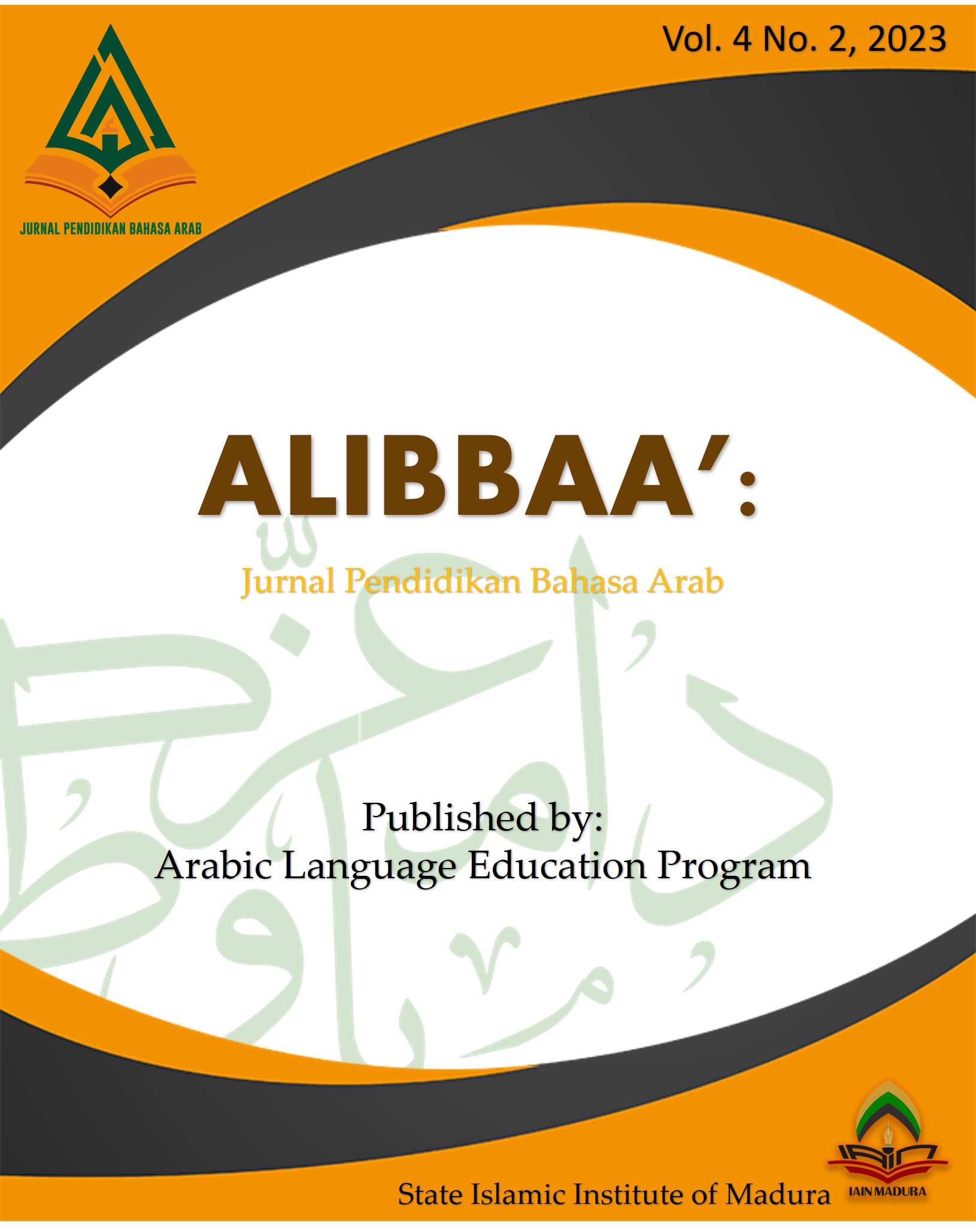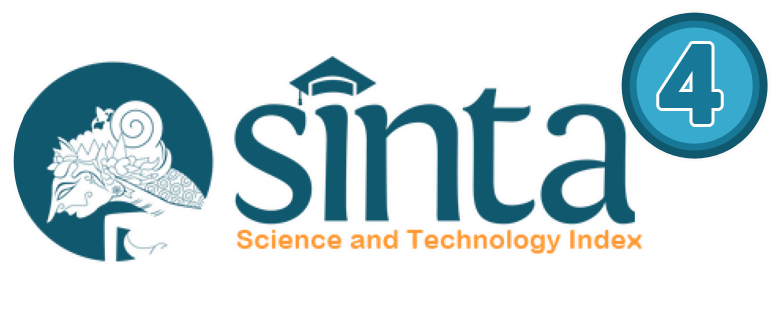Tahlîlu al-Asâlîb al-Lughawiyyah li A'dhâi Firqati al-Munâdharah al-'Ilmiyyah bi Tarbiyatil Mu'allimîn al-Islâmiyyah fî Musâbaqati al-Munâdharah al-'Ilmiyyah
 Abstract views: 180
,
Abstract views: 180
,
 pdf downloads: 258
pdf downloads: 258
Abstract
This research is motivated by the researcher's interest in the widespread phenomenon of using rhetorical language styles, namely the use of words in speaking and writing to convince or influence listeners or readers. This study focuses on the analysis of the style of language used by members of the Arabic debate group. This study uses a qualitative approach with a descriptive-analytic type. The primary data source was taken from the documentation of 22 video debates recorded during the Arabic language debate competition which was participated in by the TMI Al-Amien Prenduan students' debate group both at the national and international levels. Researchers carried out a series of steps in analyzing data starting from reducing data, presenting data, and realizing data. The results of this study indicate that; 1) There are 26 language styles with 369 variations used by the debate groups; 2) Each style of language and its variations have their own purpose. The results of this study can be the main reference for researchers in the field of Arabic.
Downloads
References
إعداد وتنسيق اللجنة، دليل مسابقة المناظرة باللغة العربية بين الجامعات ومؤسسات التعليم العالي على مستوى دول جنوب شرق آسيا (آسيان)، جامعة العلوم الإسلامية ماليزيا، 2018.
إعداد وتنسيق اللجنة. دليل مسابقات المناظرة باللغة العربية بين الجامعات ومؤسسات التعليم العالي على مستوى دول جنوب شرق آسيا (آسيان)، جامعة العلوم الإسلامية ماليزيا، 2018.
Agus Tricahyo. “Stilistika Al-Qur’an - Memahami Fenomena Kebahasaan Al-Qur’an dalam Penciptaan Manusia.” Jurnal Dialogia 12, No. 1 (2014) https://jurnal.iainponorogo.ac.id/index.php/dialogia/article/view/301
Ahmad hafidz Abdullah, dkk. “Analisis Kesalahan Sintaksis dan Morfologis pada Video Lomba Debat Bahasa Arab.” Jurnal El-Ibtikar 10, No. 1 (2021) https://syekhnurjati.ac.id/jurnal/index.php/ibtikar/article/view/8016
Ahmad Fajri Fadli, dkk. “The journey Ar-Rihlah: Analisis Gaya Bahasa Perbandingan.” Jurnal Shaut Al-”Arabiyah, Vol. 10, No.2 (Desember 2022) https://journal.uin-alauddin.ac.id/index.php/Shautul-Arabiyah/article/view/34141
Aminuddin. STILISTIKA Pengantar Memahami Bahasa dalam Karya Sastra. Semarang; CV. IKIP Semarang Press, 1995.
Dasep Bayu Ahyar, “Analisis Teks dalam Penelitian Kebahasaan (Sebuah Teori dan Aplikatif), Shaut Al-Ara’biyah : Vol. 07 Nomer. 02 (2019), https://journal.uin-alauddin.ac.id/index.php/Shautul-Arabiyah/article/view/10273/7429
Dian Uswatun Hasanah, dkk. “Analisis Penggunaan Gaya Bahasa Pada Puisi-Puisi Karya Fadli Zon.” KEMBARA : Jurnal Keilmuan Bahasa, Sastra dan Pengajarannya, Vol. 5 No. 1 (April 2019) : 18 https://ejournal.umm.ac.id/index.php/kembara/article/view/8187
Firdaus Aritonang, dkk. “Analisis Gaya Bahasa pada Syair Sidang Fakir Empunya Karya Hamzah Fansuri.” ASAS : Jurnal Sastra, Vol. 9 No. 1 (Juni 2020) https://jurnal.unimed.ac.id/2012/index.php/ajs/article/view/18344
Juniar Amalia Hendraningsih, “Ragam Gaya Bahasa Untuk Anak: Analisis Stilistika Arab atas Kitab Ayyuhal Walad Karya Imam Ghazali.” Jurnal Alfatin, Vol. 5 No. 2 (Juli-Desembar 2022) https://e-journal.metrouniv.ac.id/index.php/al-fathin/article/view/5413
Keraf, Gorys. Diksi dan Gaya Bahasa. Jakarta : Gramedia, 2006.
Mahmudah Nursolihah, “Kesantunan Berbahasa Politisi dalam Acara Diskusi di Mata najwa Trans7 serta Pemanfaatannya sebagai Bahan Ajar Teks Debat di SMA.” Repository Universitas Pendidikan Indonesia, (2019).
Azis Aji Abdilah dkk, “Effectiveness of Arabic Dabate Community to Improve Student’s Arabic Speaking Skills”, ATHLA : Journal of Arabic Teaching, Linguistic and Literature, Vol. 3 No. 2 (Desember 2022) : https://ejournal.uinsaid.ac.id/index.php/athla/article/view/5668
Meleong, Lexy J. Metodologi Penelitian Kualitatif. Bandung :Rosda, 2005.
Miftahul Ilmi,“Gaya Bahasa dalam Syi’ir Ikhtari Karya Nizar Qabbani : Studi Stilistika” Alsuniyat: Jurnal Penelitian Bahasa, Sastra Buadaya Arab 04, No. 2 (Oktober 2021) https://ejournal.upi.edu/index.php/alsuniyat/article/view/37261
Mia Mutmainah, “Gaya Bahasa Pidato Mahmoud Abbas (Kajian Stilistika Perspektif Gorys Keraf.” Jurnal : AL-AZHAR INDONESIA SERI HUMANIORA Vol. 7 No. 3 (November 2022) https://jurnal.uai.ac.id/index.php/SH/article/view/1235
Sriwahyuni, I Ayu Ketut. Nyoman Dantes, A.A. Istri Ngurah Marhaeni. Pengaruh Implementasi Metode Debat Terhadap Keterampilan Berbicara Bahasa Inggris Ditinjau dari Minat Belajar Kelas XI IPA SMA Negeri 2 Amlapura. Jurnal Administrasi Pendidikan. Universitas Pendidikan Ganesha : Pascasarjana, 2013 https://ejournal-pasca.undiksha.ac.id/index.php/jurnal_ap/article/view/1014
Team Penyusun. WARKAT, Warta Singkat. Sumenep : Pondok Pesantren Al-Amien Prenduan, 2018.
Widarmana, I Gede Putu. I Made Yudana, I Nyoman Natajaya. Pengaruh Metode Debat Terhadap Kemampuan Berbicara dalam Bahasa Inggris Ditinjau dari Ekspektasi Karir Bahasa Inggris Pada Siswa Kelas XII SMAN 1 KERAMBITAN. Jurnal Administrasi Pendidikan. Universitas Pendidikan Ganesha : Pascasarjana, 2015 : https://ejournal-pasca.undiksha.ac.id/index.php/jurnal_ap/article/view/1014
Jannah, Fithrotul. Pembelajaran Debat Bahasa Arab Melalui Model International Universities Arabic Debating Championship (IUADC) Qatar, Jurnal. Universitas Negeri Malang, Fakultas Sastra, 2017.
Muhammad Zaky Sya’bani, “Kajian Balaghah dalam Al-Qur’an Surat Luqman.” Jurnal Al-Fatin, Vol. 2, No.2 (Juli-Desember 2019) : https://e-journal.metrouniv.ac.id/index.php/al-fathin/article/view/1902
Meleong, Lexy J. Metodologi Penelitian Kualitatif. Bandung : Rosda, 2005.
Mira Khoirina, “Gaya Bahasa Majalah National Geographic Indonesia Edisi Juli-Desember 2018.” ILMU BUDAYA: Jurnal Bahasa, Sastra, Seni dan Budaya, Vol.5 No.1 (Januari 2021) : https://e-journals.unmul.ac.id/index.php/JBSSB/article/view/3027
Muhdie Amir Karim, “Pemahaman Makna Kedamaian dan Gaya Bahasa Syair Assalam karya Anis Chaucane (Analisis Stilistika).” Nady Al-Adab : Jurnal Bahasa Arab, Vol.18 No.1 (Mei 2021) : https://journal.unhas.ac.id/index.php/naa/article/view/13384
Qalyubi, Syihabuddin. ‘Ilm Al-Uslub, Stilistika Bahasa dan Sastra Arab. Yogyakarta : Idea Press, 2017.
Rahma Salbia,“Gaya Bahasa dalam Puisi Ahinnu ila Khubzi Ummi Karya Mahmoud Darwish.”AL-MA’RIFAH: Jurnal Budaya, Bahasa dan Sastra Arab, Vol.19 No.1 (April 2022) https://journal.unj.ac.id/unj/index.php/jba/article/view/26138
Rasyad, dkk. “TANBĪH AL-MĀSYI AL-MANSŪB ILĀ TARĪQ AL-QUSYASYĪ: Analisis Uslub Bahasa Arab dalam Karya ‘Abd Ar-Rauf As- Singkili.” Jurnal ADABIYA, Vol. 18, No. 2 (Agustus 2016) : https://jurnal.ar-raniry.ac.id/index.php/adabiya/article/view/1205
Rijal Mahdi, dkk. “Analisis Kesalahan Bahasa dan Disksi Para Debator dalam Debat Ilmiah Bahasa Arab Muktamar ITHLAK IX.” Jurnal Al-Ma’rifah 19, No. 1 (2022) https://journal.unj.ac.id/unj/index.php/jba/article/view/26137
Authors who publish with this journal agree to the following terms:
a. Authors retain copyright and grant the journal right of first publication with the work simultaneously licensed under a Creative Commons Attribution License that allows others to share the work with an acknowledgement of the work's authorship and initial publication in this journal.
b. Authors are able to enter into separate, additional contractual arrangements for the non-exclusive distribution of the journal's published version of the work (e.g., post it to an institutional repository or publish it in a book), with an acknowledgement of its initial publication in this journal.
c. Authors are permitted and encouraged to post their work online (e.g., in institutional repositories or on their website) prior to and during the submission process, as it can lead to productive exchanges, as well as earlier and greater citation of published work (See The Effect of Open Access).
Alibbaa': Jurnal Pendidikan Bahasa Arab have CC-BY-SA or an equivalent license as the optimal license for the publication, distribution, use, and reuse of scholarly work.
In developing strategy and setting priorities, Alibbaa': Jurnal Pendidikan Bahasa Arab recognize that free access is better than priced access, libre access is better than free access, and libre under CC-BY-SA or the equivalent is better than libre under more restrictive open licenses. We should achieve what we can when we can. We should not delay achieving free in order to achieve libre, and we should not stop with free when we can achieve libre.

Alibbaa': Jurnal Pendidikan Bahasa Arab is licensed under a Creative Commons Attribution 4.0 International License
You are free to:
- Share — copy and redistribute the material in any medium or format
- Adapt — remix, transform, and build upon the material for any purpose, even commercially.
- The licensor cannot revoke these freedoms as long as you follow the license terms.











